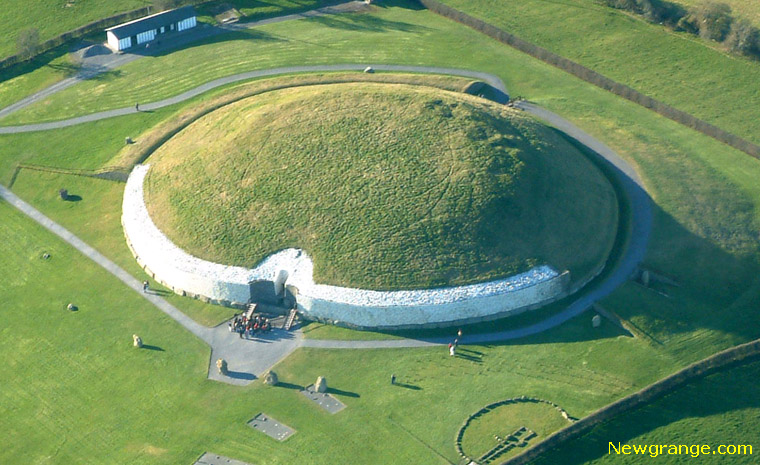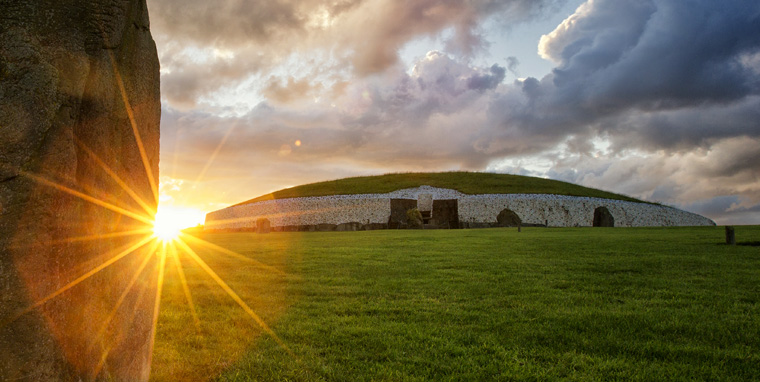Newgrange "A Salt Cellar - Not a Tomb" - Meath Farmer's Claim
An article in the Meath Cronicle 19 April 1980"Newgrange was not a tomb - it was a salt cellar". With this dramatic declaration, the unassuming Meath farmer threw out a challenge to those scientists and archaeologists who support the theory that this famous 5,000-year-old structure is a passage grave.
Interviewed by a Meath Chronicle reporter, Mr Paddy Prendergast, Johnstown, Enfield, by an amalgam of inductive and deductive reasoning, questions, surmises, inferences and commonsense, linked Newgrange with central Asia.
"Who told us it was a tomb?" he asked rhetorically. He then proceeded to lay the foundations of his case.
Dry Stones
The stones used were dry stones. There were channels in them to divert water from the chamber. There was a flag stone and on top of it a stone basin. There was a fall from the chamber down to the doorway to keep damp out.If there was valuable stuff in the chamber, one man could keep a lot of robbers out. There was a white face to the stone outside. The building was situated on the highest point in the area.
There are 22 stones on one side of the passage and 22 on the other. Why was each side made so strongly? Presumably because a lot of people would be going up and down the passage.
Businessmen
Mr Prendergast puts forward the rather startling claim that the Newgrange area was originally a large town or city and that the so-called tomb was built by businessmen for profit.He infers to whatever we started there was valuable and had to be kept dry. What was stored in the chamber? His answer - salt.
He argues that, before rock salt was discovered, people had to live by the sea. They could not live for any length of time inland without salt. It could not be mined then, because the people had no iron tools.
Where did the Newgrange salt come from? There was only one place - the salt deserts of central Asia. He infers that the salt was exchanged for gold from Ireland.
Furthermore, he believes that the pyramids of Egypt were not tombs either, but were built to store gold and other precious objects that the nomadic tribes could not carry around with them.
Returning to Newgrange, he argued that the big stone outside the structure was the world's first shop counter. The builders of the structure were wholesalers of salt.
Advertising
Asked to explain the markings on the stones, he attached little significance to them. He thinks they were advertising matter, like the horse-shoe door that used to be favoured by blacksmiths. The white stone face also advertised salt, he submitted.The foregoing is little more than a resume of Mr Prendergast's thesis. Whether or not the thesis possesses any "bane" he has come up with an interesting picture of Newgrange in 3,000 B.C.
There is negative support for his anti-tomb claim. All traces of burial and of grave-goods are missing from Newgrange.
Boyne Valley Private Day Tour
 Immerse yourself in the rich heritage and culture of the Boyne Valley with our full-day private tours.
Visit Newgrange World Heritage site, explore the Hill of Slane, where Saint Patrick famously lit the Paschal fire.
Discover the Hill of Tara, the ancient seat of power for the High Kings of Ireland.
Book Now
Immerse yourself in the rich heritage and culture of the Boyne Valley with our full-day private tours.
Visit Newgrange World Heritage site, explore the Hill of Slane, where Saint Patrick famously lit the Paschal fire.
Discover the Hill of Tara, the ancient seat of power for the High Kings of Ireland.
Book Now
Home
| Visitor Centre
| Tours
| Winter Solstice
| Solstice Lottery
| Images
| Local Area
| News
| Knowth
| Dowth
| Articles
| Art
| Books
| Directions
| Accommodation
| Contact



